About Me
Michael Zucchi
B.E. (Comp. Sys. Eng.)
also known as Zed
to his mates & enemies!
< notzed at gmail >
< fosstodon.org/@notzed >

A browser ... ?
Ahh, so I totally didn't think I was going to even try to do this ...But epub needs HTML, and I found CSSBox, and well one thing lead to another ...
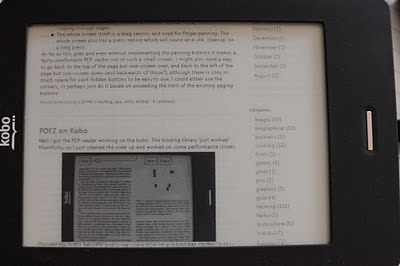
So I've basically ported the SimpleBrowser example from CSSBox to ReaderZ - all it can do is render the page, and it lets you pan and zoom as with PDF files. No links or anything.
I tried rendering on the fly, and into an image - the former is a little slow to scroll (but not far off the e-ink speed), but I don't think it's clipping the drawing regions properly and so doing a lot more work than necessary anyway. Using an image scrolls fast but can't be zoomed very well, and takes more memory (I blew it with boycottnovell) ... so trade-offs.
It's pretty slow and clunky, but what can one expect when XML is involved?
Reader Shell
So I kept poking away at the browser code and my gadget toolkit.
It's getting fairly sophisticated now: I improved the StackLayout gadget to add filling and relative sizing glue. I added a list gadget - which works by pages, and is similar to JList, including a cell renderer, list model and selection model and I played around with a whole lot of other stuff as well.
So I have enough to finally create a reader shell: it presents a list of the files on the device, and lets you open them up with a pdf reader or a text reader, depending on the file type. Once inside it has a full-screen viewer with no visible buttons - but without buttons you can zoom, pan, change pages one at a time or flip through many a time. A popup menu (single short press in the middle of the screen) lets you quit back to the shell.
I cache the pagination for text files, so they open very quickly after the first visit, assuming the font settings haven't changed. The pagination descriptor is small, about 7k for a 500 page document. On a re-visit of the same file (i.e. once the jvm is warmed up), it's loading 500k text file in about 1/2 a second but even from a cold-start it's only about a second. PDF files also open fast, about the same speed. i.e. not much slower than the e-ink can refresh a single greyscale page. Closing a file and returning to the shell is similarly speedy.
And whilst the interface isn't very complicated, everything is still quite responsive, with no missed finger presses or long unexplained delays (although the first time you open a 500k text file, it still takes about 25s to re-paginate).
My panning is still a bit slow, although I am rendering the bitmap on the fly as well.
But ... i've pretty much done what I want for now: prove that the kobo touch e-reader is a zippy little unit, capable of much more performance than the included software lets it deliver.
I'll drop the code in MediaZ sometime in the next few days, and continue working on it for at least a while.
PDFZ
Checked in the first cut of PDFZ to the MediaZ project.
It's a simple binding to muPDF - i.e. a PDF renderer for Java that builds on arm and x64/x86 cpus.
Touch Interfaces 2
I was wondering how to get a decent user interface with only a finger ...
I came up with the idea of sensors (no doubt this is what everyone else already does, but I haven't used a touch device before let alone coded for one) that I can attach to a gadget, and the gadget can then decide what to do.
I have two types of sensors, drag sensors and press sensors. Drag sensors override any press sensors, and come into action once a drag has started. It only started after a certain threshold of movement is exceeded. Press sensors only activate if a press is detected without a drag. Additionally they can handle long (>300ms) or short presses separately.
So for a PDF viewer, I came up with the following 'soccer pitch' of sensors ...
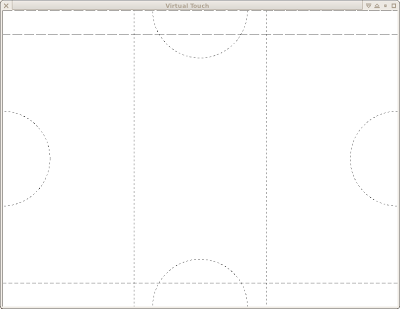
- The semi-circle sensors are press sensors, and are used to pan around the page in screen-sized chunks in the obvious directions. I haven't implemented these yet.
- The left and right thirds of the entire screen are for page turning.
- The thin rectangle at the top of the screen is a drag sensor used for changing the zoom. There is also a coincident press sensor which is used to reset the zoom.
- The thin rectangle at the bottom of the screen is a drag sensor used for flipping through pages.
- The whole screen itself is a drag sensor, and used for finger panning. The whole screen also has a press sensor which will cause an e-ink 'cleanup' on a long press.
As far as this goes and even without implementing the panning buttons it makes a fairly comfortable PDF reader out of such a small screen. I might also need a way to go back to the top of the page but one-screen over, and back to the left of the page but one-screen down (and backwards of those?); although there is only so much space for such hidden buttons to be easy to use. I could either use the corners, or perhaps just do it based on exceeding the limit of the existing paging buttons.
PDFZ on Kobo
Well I got the PDF reader working on the kobo. The binding library 'just worked' thankfully, so I just cleaned the code up and worked on some performance issues.
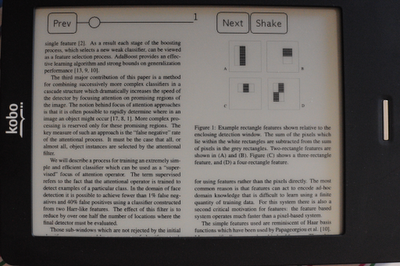
Using a custom BufferedImage which talks directly to the ByteBuffer turned out to be very slow on the kobo jvm - about 10x slower than just copying the ByteBuffer to an RGB565 BufferedImage in a manual Java loop. So I just do that ... the images are only the size of the display so memory isn't a big issue.
It loads and renders a page in about 0.3s, so that is fast enough. I couldn't work out how to get it to 'fully' refresh automatically very cleanly so I just added a button to do it. Panning is a bit slow, even with monochrome update mode: OTOH finger events aren't lost when you press-slide-quickly-release.
For comparison here's the same text with the built-in viewer.
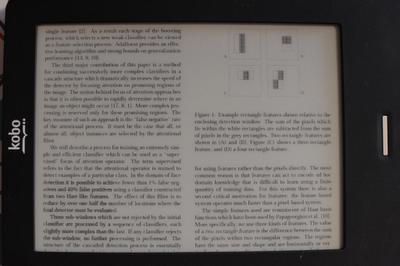
I think my last mention if it was a bit unkind - it isn't that bad, it turns out I had been reading a scanned paper, which tends to render poorly in everything. I found out that you can change pages whilst zoomed, although you either have to scroll off the side of the image first, or bring up the menu - and while the menu is up you get an icon of the 'zoom area' taking up a good chunk of the screen, so they're both a little bit clumsier than they might be. And some contrast enhancement wouldn't go astray when viewing text (although IMHO mupdf just renders text very well).
Incidentally, the dark square you can see in the lower left is really there: it's left over from an e-ink refresh after the zoom-preview-box is removed.
PDFZ, mupdf
Cut a long story short: i've come up with a simple binding to mupdf for Java.
I was going to just use jmupdf, but on closer inspection it had some issues I wasn't comfortable with. By writing my own it let me use the development version of mupdf: which has support for multiple threads and so on, and so removes the need for some of the work that had been done in jmupdf to 'libaryise' it. All I needed to do to mupdf was add -fPIC to CFLAGS so I could build a shared library out of the jni plugin.
Rather than bind the whole api (it's huge), i've bound a minimum required to load pdfs for display. A helper class written in C hides some of the mucking about when loading and rendering pages.
Obviously one thing that got me started on this was for a pdf viewer on the kobo touch ... although i'm not really convinced the display has enough resolution for it to work that well. I tried the built-in pdf viewer but it's pretty tedious to use - you can't turn pages unless you're fully zoomed out, and with the file I was testing it had the bounding box wrong so you had to do a lot of zoom in/out just to be able to read anything. Panning on the e-ink is a bit nasty too.
I haven't tried running it yet on the kobo: but i've already built the binaries using a cross-compilation environment so hopefully it should 'just work'. I've also made some progress on a GadgetZ based implementation, but it's super rough, here's a screenshot of it running on my workstation in my 'emulator'. I've upped the gamma somewhat in preparation for the e-ink and to test that functionality (which is why it is so dark).
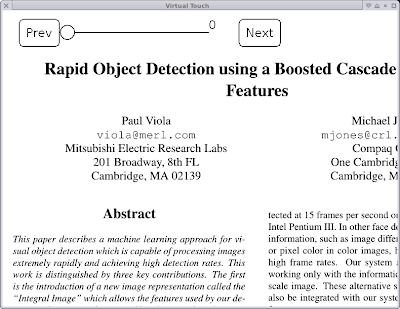
I'm going to try to see if i can render the display list real-time, and only keep a frame-buffer sized backing for it. It's fast enough on the desktop, but i'm not sure about the ARM cpu on the kobo when it comes to panning (at the zoom setting shown in the picture it's taking about 0.002-0.004s to render on my workstation ... so it should be fast enough!).
The user interface with a single 'finger' input will be a challenge too ...
I crashed my kobo a couple of days ago whilst trying to work out suspend/resume, and spent a few wasted hours trying to activate it again after a factory reset since the windows pc I have access to suddenly decided to have it's hdd die ... so i'm a little reluctant to overuse it at the moment (although I ended up setting up the kobo application in virtualbox, should i need it again).
I've also had enough for today, so I'll look at the kobo another time.
Touch Interfaces
Although I should really be working on the shed or just getting some fresh air, I kept poking away at the kobo code.
I thought i'd try to implement a copy of the 'date setting' thing: the one on the kobo is really slow and hard to use for some reason and I wanted to verify that it wasn't a fault of the device ...
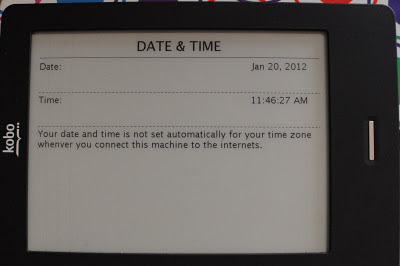
(this is similar-but-not the same as the kobo date setting page)
Rather than copy the same interface (which is based on selecting what to change and up/down buttons), I came up with a different one based on more 'standard' widgets: dropdown menu's and sliders.
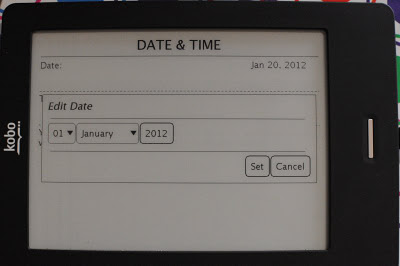
I'm also using a new 'requester' class, which is a modal window which opens centered on the screen.
Of course, the problem with writing your own toolkit is you need to write all those things too ... but I managed to get those working eventually. The popup menu will try to align with the selected item, otherwise it fits to the screen.
I hit my first snag when trying to create requesters: the event loop iterates through a list of gadgets, but that ended up changing during the update since I was adding a new window ... so my first solution was to hack the popups in separately to the Screen class: it needs to track them for events anyway. I knew that although I wasn't hitting it at the moment, there was also a potential for multi-thread issues as well, so I attempted to create a work-around for that too. I removed access to the children of a Group gadget, and forced access through a synchronous interface which makes a copy of the list. Although it can potentially access stale data, it should eventually catch up.
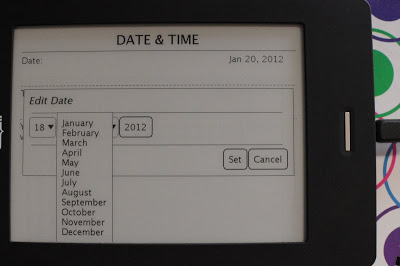
I'm using a layout class for the layout of the menu content, so although it's not shown, the 'day' selector uses a grid layout and lists the day numbers in quasi-calendar format.
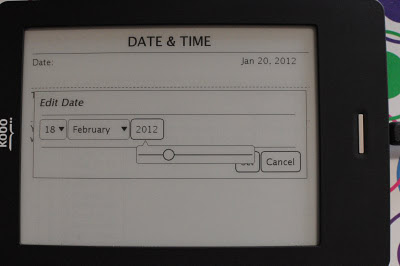
For the year I thought i'd try something different - a slider bubble, which just goes away once you lift your finger.
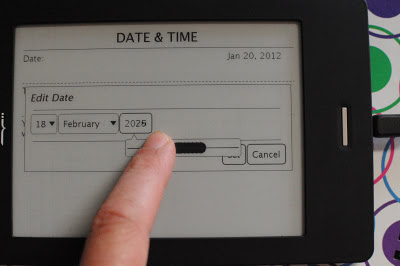
In action ... showing the faster update mode. I can also set it to update synchronously - in this case you get no artefacts, but it only updates about 3fps.
I also poked around with the update manager a fair bit. I had been just shipping repaint events to another thread and letting it merge them if it happened to have a few in the queue. But this meant the display would update quickly as soon as something changed and then usually the rest of the updates for handling that input would happen later: i.e. at least 2 updates (which are slow if you're waiting for them). So I now have it merge the updates as they come in, and only fire them off after processing input events. There is still some issues with this for the e-ink, e.g. if you do anything on an input 'pressed' event such as highlighting a button, and then perform the action on the 'released' event you still end up having to wait for at least one redundant updates - which again is slow if you're synchornising with the e-ink.
I also experimented with an 'invert' display every now and then: e.g. when a requester is closed. This is needed to clean up the e-ink fully. Here I hit some snags with synchronisation with the device driver although I have it sort of working. Sometimes it inverts the old data first, and then inverts the final data, even though i'm ensuring the updates are being sent in order. I am just using the same update maker though, so it probably has something to do with that.
Finally, I tried to work out how to resume from suspend but got nowhere - I can suspend the box but it wont resume on any button presses and I have to do a hardware reset.
GadgetZ ... on kobo.
So the projects of the ...Z's continue.
I played a bit with the thinlet toolkit - I managed to get some stuff to display, but I had trouble with the refreshing and mapping the input events properly. It also lacked some features and had a weird-arsed reflection based event system.
So, although I really didn't want to, I started from scratch with a 'simpler' toolkit. Which wasted all of today and half of yesterday ...
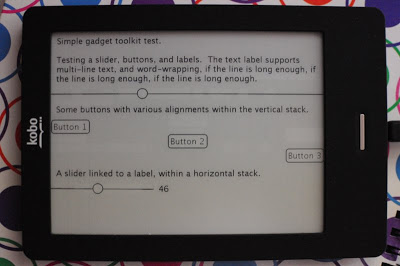
But after quite a bit of jiggery pokery I have some basic widgets working (as usual, it's the layout stuff that's a real shit to get working at all, let alone correctly). All events are handled in one thread, and all rendering his handled in another - so although you sometimes get artefacts, it ends up catching up: and the interface remains quite responsive in the meantime (so it should, there are at least 5 threads working away so nothing needs to block). The touch-screen does seem to have some issues with some areas of the screen but I don't think I can do anything about that.
I also worked out the input events for the two buttons (home and power) - for some reason when I tried it previously I got nothing. So when I get to that I can hook those up too.
The paint manager isn't terribly efficient - but it seems to be 'good enough' at this point even with piles of printf output. i.e. the cpu on the thing really is rather gutsy particularly compared to the slowness of the e-ink display.
Next time I play with it i might look at a text reader. Unfortunately paginating isn't quite as simple as i'd like - I wanted to read it off disk on the fly: but character set and word-wrap stuff makes this really messy. So to start with it might be based in memory.
Update Whilst I was writing this I had a bit more of a play. If I turn off anti-aliasing and use black and white for everything, the display updates much faster and with fewer artefacts.
Copyright (C) 2019 Michael Zucchi, All Rights Reserved.
Powered by gcc & me!











